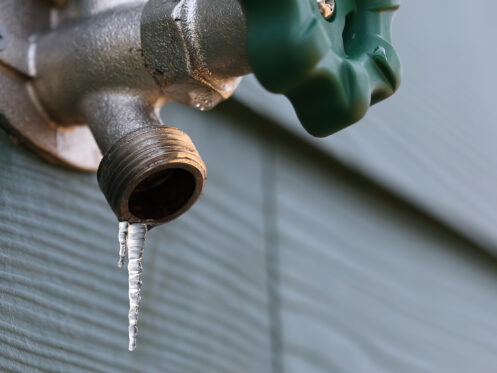Are you looking for ways to protect your plumbing and prevent your pipes from freezing this winter? Outdoor plumbing fixtures like hose spigots can be especially prone to freezing during cold weather, which is why it’s essential that your house has frost-proof hose bibs. In this article, we’ll explain how frost-proof hose bibs work and give you some other tips to prevent your plumbing from freezing.
The Difference Between Standard and Frost-Proof Hose Bibs
A hose bib enters through the exterior of the building and connects to a water line inside. There is then a shut-off valve where the hose bib meets the water line that allows you to turn the water to the bib on and off from inside. Standard hose bibs are short, which means they just barely enter inside and attach to the water line that is next to the wall. Frost-proof hose bibs have a longer stem that enters at least several inches inside.
The issue with standard hose bibs is that you have the water pipe right next to the top of the foundation wall. This is where the air temperature can still get extremely cold during the winter even when the rest of the house is sufficiently warm. Even if you close the shut-off valve and drain the hose bib, there is a high chance that the water in the pipe feeding the bib can end up freezing in cold weather. A frozen pipe is an extremely serious issue since the pipe will often end up bursting and causing a flood. A polyurethane PEX pipe usually won’t burst if the water in it freezes since the pipe can expand. A copper pipe, on the other hand, is quite rigid. That means that as the water turns into ice and expands, it can exert enough pressure on the pipe that it ruptures and starts leaking.
If you have a frost-proof hose bib, there is very little chance of the pipe that feeds it freezing. That’s because the stem on the bib sticks far enough inside where the air stays much warmer so you don’t end up with water remaining in the pipe right next to the wall.
You can tell the difference between standard and frost-proof hose bibs just by how they look. On a standard bib, the wheel or handle you use to turn the water on and off usually sits horizontally on top of the bib just above where you attach a hose. On a frost-proof bib, the wheel is vertical and at the end of the bib. Frost-proof bibs also typically have an anti-siphon valve on top near where the bib meets the wall.
Why You Need to Shut Off and Drain Your Hose Bibs
Even if you have frost-proof hose bibs on all your outdoor spigots, it’s still essential that you shut them all off from inside your house and then drain them. If you don’t take this step, water will remain in the bib and the stem that is inside. That means there is a high chance that the bib will freeze, which in turn will likely cause the water line to also freeze and possibly burst. Even if the water line itself doesn’t freeze, there’s a good chance that the hose bib will get damaged, and you’ll then need to replace it. The bib is also made of copper. It could still end up rupturing and causing a major leak inside your house.
It’s important that you monitor the weather once fall arrives so that you know when the first major frost is predicted to hit your area. Before this happens, you should make sure to disconnect all your hoses. If you don’t, you may not be able to drain your hose bibs properly. They could still end up freezing. After disconnecting and rolling up all your hoses so you can store them for the winter, the next step is to close the valve on the pipe that supplies each hose bib. You can then go outside and turn each bib on until no more water drains out. It’s essential that you remember to fully shut each bib back off. If you leave the bib open, cold air can flow up through and potentially cause the water line to freeze even if the valve is shut off.
If you have an outdoor kitchen with a sink, you need to make sure to shut the water to it off and drain the pipes. You’ll always have the same type of shut-off valve inside your house on the water lines that supply the outdoor sink. If you have both hot and cold water outside, there will be a separate valve on each line. After closing these valves, you then want to drain the hot and cold-water lines individually just to make sure all of the water fully drains out of them.
Other Tips for Preventing Frozen Pipes This Winter
While hose bibs and other outdoor plumbing fixtures have the greatest chance of freezing, the pipes inside your house can also freeze if you don’t take certain precautions. One of the most important things to do if you have any pipes in a crawl space or attic is to make sure they are fully insulated. Foam pipe insulation slides right over the pipe and should then be secured with tape. This is to ensure there are no gaps or spaces where part of the pipe is exposed. If your pipes are already insulated, it’s still a good idea to check them before winter arrives since foam insulation tends to deteriorate over time and can start falling apart. If the insulation is brittle or starting to crumble, you should make sure to have it replaced in anticipation of freezing temperatures.
Even if most of your pipes are in the basement, you may still want to consider insulating them. Older homes often have issues with cracks in the foundation or holes near the top of the foundation wall where things like the gas line enter the house. These issues can result in the area next to some of the foundation walls getting cold enough that any exposed pipes could freeze. If you can feel cold air near your main water line or the pipes that branch off it, it’s a good idea to insulate these pipes so that they aren’t at risk of freezing.
When extremely cold weather is predicted, you should take some additional steps as well to protect your pipes. If you have any kitchen or bathroom fixtures located on an exterior wall, you should turn them on so that there is a constant trickle of water running. Even if your home is warm, pipes located within an exterior wall can easily freeze. If there is water moving through the pipes instead of just standing still, they usually won’t freeze. Another option that can be effective is to open the doors to the cabinets underneath your sinks so that warm air can get inside.
For nearly 25 years, 3 Mountains Home Services has been providing expert plumbing services in Milwaukie, Portland and the surrounding areas. We’re ready to help if you need to upgrade your home with frost-proof hose bibs or need any other installation or repair services. You can also count on our team for all your heating, air conditioning and electrical needs. For more information or to schedule a service appointment, contact 3 Mountains Home Services today.


